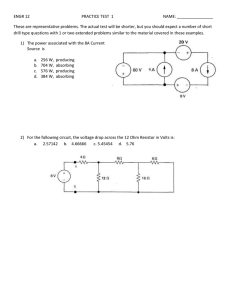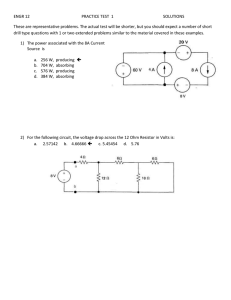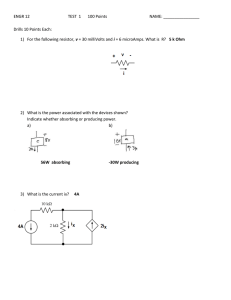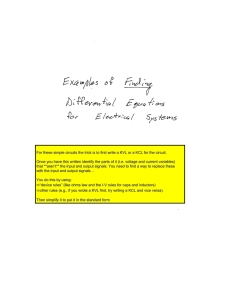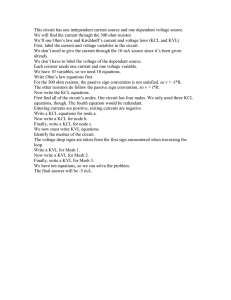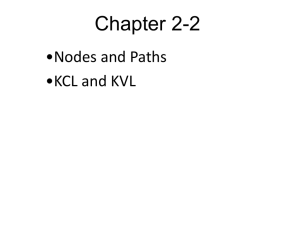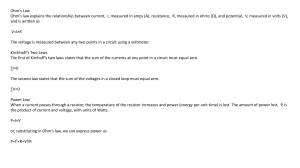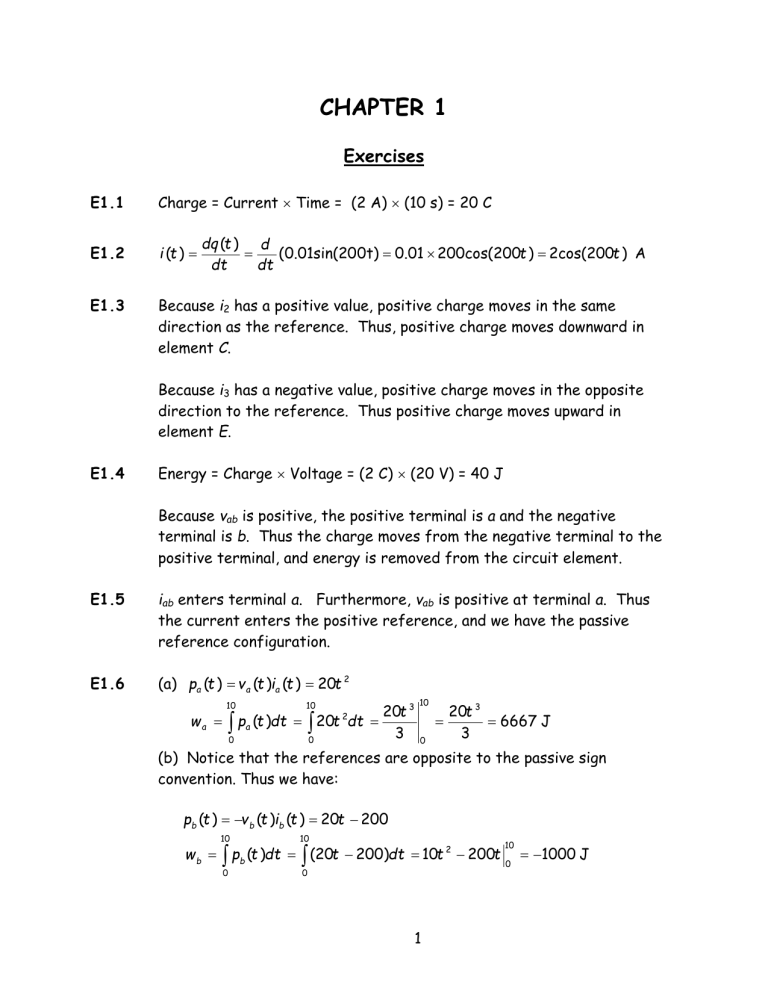
CHAPTER 1 Exercises E1.1 Charge = Current Time = (2 A) (10 s) = 20 C E1.2 i (t ) E1.3 Because i2 has a positive value, positive charge moves in the same direction as the reference. Thus, positive charge moves downward in element C. dq (t ) d (0.01sin(200t) 0.01 200cos(200t ) 2cos(200t ) A dt dt Because i3 has a negative value, positive charge moves in the opposite direction to the reference. Thus positive charge moves upward in element E. E1.4 Energy = Charge Voltage = (2 C) (20 V) = 40 J Because vab is positive, the positive terminal is a and the negative terminal is b. Thus the charge moves from the negative terminal to the positive terminal, and energy is removed from the circuit element. E1.5 iab enters terminal a. Furthermore, vab is positive at terminal a. Thus the current enters the positive reference, and we have the passive reference configuration. E1.6 (a) pa (t ) v a (t )ia (t ) 20t 2 10 10 20t 3 w a pa (t )dt 20t dt 3 0 0 10 2 0 20t 3 6667 J 3 (b) Notice that the references are opposite to the passive sign convention. Thus we have: pb (t ) v b (t )ib (t ) 20t 200 wb 10 p 0 b 10 (t )dt (20t 200)dt 10t 2 200t 0 1 10 0 1000 J E1.7 (a) Sum of currents leaving = Sum of currents entering ia = 1 + 3 = 4 A (b) 2 = 1 + 3 + ib ib = -2 A (c) 0 = 1 + ic + 4 + 3 ic = -8 A E1.8 Elements A and B are in series. Also, elements E, F, and G are in series. E1.9 Go clockwise around the loop consisting of elements A, B, and C: -3 - 5 +vc = 0 vc = 8 V Then go clockwise around the loop composed of elements C, D and E: - vc - (-10) + ve = 0 ve = -2 V E1.10 Elements E and F are in parallel; elements A and B are in series. E1.11 The resistance of a wire is given by R substituting values, we have: 9. 6 1.12 10 6 L (1.6 10 3 )2 / 4 ρL . Using A d 2 / 4 and A L = 17.2 m E1.12 P V 2 R R V 2 / P 144 E1.13 P V 2 R V PR 0.25 1000 15.8 V I V / R 120 / 144 0.833 A I V / R 15.8 / 1000 15.8 mA E1.14 Using KCL at the top node of the circuit, we have i1 = i2. Then, using KVL going clockwise, we have -v1 - v2 = 0; but v1 = 25 V, so we have v2 = -25 V. Next we have i1 = i2 = v2/R = -1 A. Finally, we have PR v 2i2 ( 25) ( 1) 25 W and Ps v 1i1 (25) ( 1) 25 W. E1.15 At the top node we have iR = is = 2A. By Ohm’s law we have vR = RiR = 80 V. By KVL we have vs = vR = 80 V. Then ps = -vsis = -160 W (the minus sign is due to the fact that the references for vs and is are opposite to the passive sign configuration). Also we have PR v R iR 160 W. 2 Problems P1.8 The reference direction for iab points from a to b. Because iab has a negative value, the current is equivalent to positive charge moving opposite to the reference direction. Finally since electrons have negative charge, they are moving in the reference direction (i.e., from a to b). For a constant (dc) current, charge equals current times the time interval. Thus, Q (10A) (3s) 30C. P1.11 P1.13 i (t ) dq(t ) d (4 5t ) 5A dt dt Q 4 e t dt 4e t 0 P1.16 0 4 coulombs The charge flowing through the battery is Q (5 amperes) (24 3600 seconds) 432 10 3 coulombs and the stored energy is Energy QV ( 432 10 3 ) (12) 5.184 10 6 joules (a) Equating gravitational potential energy, which is mass times height times the acceleration due to gravity, to the energy stored in the battery and solving for the height, we have Energy 5.18 106 h 26.44km mg 20 9.8 (b) Equating kinetic energy to stored energy and solving for velocity, we have 2 Energy 720m/s m (c) The energy density of the battery is 5.184 106 259.2 103 J/kg 20 which is about 0.576% of the energy density of gasoline. v 3 P1.19 Q current time (10 amperes) (72, 000 seconds) 7.2 105 coulombs Energy QV (7.2 105 ) (20) 1.44 106 joules P1.21 (a) P -vaia = 15 W Energy is being absorbed by the element. (b) P vbib = 20 W Energy is being absorbed by the element. (c) P -vDEiED = -30 W P1.23 Energy is being supplied by the element. Q w V (100 J) (5 V) 20 C . To increase the chemical energy stored in the battery, positive charge should move from the positive terminal to the negative terminal, in other words from a to b. Electrons move from b to a. P1.26 Energy P Cost $10 400kWh Rate 0.10 $/kWh Energy (400)kWh 416.6W Time (40) 24h Reduction I P 416.6 4.16 A V 100 (100) 100% 24% (416.6) P1.28 (a) P 100 W taken from element A. (b) P 100 W delivered to element A. (c) P 100 W taken from element A. P1.35 Elements A and B are in series. Also, elements E and F are in series. P1.37 At the node joining elements A and B, we have ia ib 0. Thus, ia 2 A. For the node at the top end of element C, we have ib ic 3 . Thus, ic 1 A . Finally, at the top right-hand corner node, we have 3 ie id . Thus, id 4 A . Elements A and B are in series. 4 P1.38 We are given ia 1 A, ib 2 A, id 3 A, and ih 5 A. Applying KCL, we find P1.42 ic ib ia 1 A ie ic ih 6 A if ia id 2 A i g if ih 7 A Summing voltages for the lower left-hand loop, we have 10 va 5 0, which yields va 5 V. Then for the top-most loop, we have vc 30 va 0, which yields vc 35 V. Finally, writing KCL around the outside loop, we have 5 v c v b 0, which yields vb 30 V. P1.44 Applying KCL and KVL, we have ic ia id 1 A vb vd va 10 V ib ia 1 A vc vd 10 V The power for each element is PA vaia 20 W PC vcic 10 W PB vbib 10 W PD vdid 20 W Thus, PA PB PC PD 0 P1.50 V R 2 P1.55 1 P1 1002 100 100 (V2 )2 82 P2 6.4W for a 36% reduction in power R 10 5 P1.60 (a) Not contradictory. (b) A 2-A current source in series with a 3-A current source is contradictory because the currents in series elements must be equal. (c) Not contradictory. (d) A 2-A current source in series with an open circuit is contradictory because the current through a short circuit is zero by definition and currents in series elements must be equal. (e) A 5-V voltage source in parallel with a short circuit is contradictory because the voltages across parallel elements must be equal and the voltage across a short circuit is zero by definiton. P1.62 As shown above, the 4 A current circulates clockwise through all three elements in the circuit. Applying KVL, we have vc vR 5 20iR 5 85V Pcurrent source vciR 340W. Thus, the current source delivers power. PR (iR )2 R 42 20 320W. The resistor absorbs power. Pvoltage source 5 iR 20W. The voltage source absorbs power. 6 P1.64 Applying Ohm's law, we have v2 3 2 A 6 V . However,v 2 is the voltage across all three resistors that are in parallel. Thus, v 6 2A, , and i2 2 1A. . Applying KCL, we have i1 i2 i3 2 5A. . 6 3 By Ohm's law: v1 3i1 15 V . Finally using KVL, we have vx v1 v2 21 V . i3 P1.70 (a) Applying KVL, we have 6 vx 2v x , which yields vx 6 / 3 2 V (b) ix vx / 5 0.4 A (c) Pvoltage source 6ix 2.4W. (This represents power delivered by the voltage source.) PR 5(0.4)2 0.8W Pcontrolled source 2(2)(0.4) 1.6W P1.75 vx (3) (1A) 3V is vx / 3 3 4A 7 Applying KVL around the outside of the circuit, we have: v s 4(2) 3 5 26 Practice Test T1.1 (a) 4; (b) 7; (c) 16; (d) 18; (e) 1; (f) 2; (g) 8; (h) 3; (i) 5; (j) 15; (k) 6; (l) 11; (m) 13; (n) 9; (o) 14. T1.2 (a) The current Is 3 A circulates clockwise through the elements entering the resistance at the negative reference for vR. Thus, we have vR IsR 6 V. (b) Because Is enters the negative reference for Vs, we have PV VsIs 30 W. Because the result is negative, the voltage source is delivering energy. (c) The circuit has three nodes, one on each of the top corners and one along the bottom of the circuit. (d) First, we must find the voltage vI across the current source. We choose the reference shown: Then, going around the circuit counterclockwise, we have v I Vs v R 0 , which yields v I Vs v R 10 6 4 V. Next, the power for the current source is PI I sv I 12 W. Because the result is positive, the current source is absorbing energy. Alternatively, we could compute the power delivered to the resistor as PR I s2R 18 W. Then, because we must have a total power of zero for the entire circuit, we have PI PV PR 30 18 12 W. 8 T1.3 (a) The currents flowing downward through the resistances are vab/R1 and vab/R2. Then, the KCL equation for node a (or node b) is v v I 2 I 1 ab ab R1 R2 Substituting the values given in the question and solving yields vab 8 V. (b) The power for current source I1 is PI 1 v ab I1 8 3 24 W . Because the result is negative we know that energy is supplied by this current source. The power for current source I2 is PI 2 v ab I 2 8 1 8 W . Because the result is positive, we know that energy is absorbed by this current source. 2 (c) The power absorbed by R1 is PR 1 v ab / R1 ( 8)2 / 12 5.33 W. The 2 / R2 ( 8) 2 / 6 10.67 W. power absorbed by R2 is PR 2 v ab T1.4 (a) Applying KVL, we have Vs v 1 v 2 0. Substituting values given in the problem and solving we find v1 8 V. (b) Then applying Ohm's law, we have i v1 / R1 8 / 4 2 A. (c) Again applying Ohm's law, we have R2 v 2 / i 4 / 2 2 . T1.5 Applying KVL, we have Vs v x 0. Thus, v x Vs 15 V. Next Ohm's law gives ix v x / R 15 / 10 1.5 A. Finally, KCL yields i sc i x av x 1.5 0.3 15 3 A. T1.6 Applying Ohm’s law to the 40-Ω resistance, we have v 4 40i 4 80 V. Since v4 is also the voltage across the 20-Ω and 16-Ω resistances, we have i3 v 4 / 16 80 / 16 5 A and i2 v 4 / 20 80 / 20 4 A. Then applying KCL to the node joining the resistances, we have i1 i2 i3 i 4 11 A. Then, applying Ohm’s law to the 10-Ω resistance, we have v 1 10i1 110 V. Finally, applying KVL, we have v s v 1 v 4 190 V. 9
